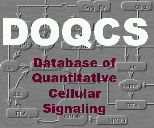
|
Enter a Search String | | Special character and space not allowed in the query term.
Search string should be at least 2 characters long. |
Molecule Parameter List for Rec-Gq | The statistics table lists the distribution of a molecule acting either as a substrate, product, enzyme or as a molecule within the network.
The text color of a molecule is highlighted by  color. color. | | Statistics |
Accession and Pathway Details | |
| Accession Name | Accession No. | Accession Type | Pathway Link | Osc_Ca_
IP3metabolism | 24 | Network |
MIPP, CaMKII, CaM,
PKC, IP3-3K, Gq,
PLCbeta, 134_dephos, 145_dephos,
IP4-system, IHP-system, 1345_dephos,
CaRegulation, Othmer-Tang-model | | This network models an oscillatory calcium response to GPCR mediated PLCbeta activation, alongwith detailed InsP3 metabolism in the neuron. It differs from the NonOsc_Ca_IP3metabolism network in the CaRegulation module and in InsP3 receptor kinetics. Details of InsP3 receptor kinetics have been adapted from the Othmer-Tang model for oscillatory Ca dynamics. Mishra J, Bhalla US. Biophys J. 2002 Sep;83(3):1298-316. |
Rec-Gq acting as a Molecule in Osc_Ca_IP3metabolism Network
| Name | Accession Name | Pathway Name | Initial Conc.
(uM) | Volume
(fL) | Buffered | | Rec-Gq | Osc_Ca_
IP3metabolism
Accession No. : 24 | Gq
Pathway No. : 125 | 0 | 1000 | No | | Turns out that a large fraction of the the receptor binds to the G-protein even in the absence of ligand. This pool represents this step. Fraction of Rec-Gq is 44% of receptor, from Fay et al 1991 Biochem 30:5066-5075 Since this is not the same receptor, this value is a bit doubtful. Still, we adjust the rate consts in Rec-bind-Gq to match. |
Rec-Gq acting as a Substrate in a reaction in Osc_Ca_IP3metabolism Network
| Kd is calculated only for second order reactions, like nA+nB <->nC or nA<->nC+nD, where n is number and A,B,C,D are molecules, where as for first order reactions Keq is calculated.
Kd for higher order reaction are not consider. |
| | Name | Accession Name | Pathway Name | Kf | Kb | Kd | tau | Reagents | | 1 | Glu-bind-Rec-Gq | Osc_Ca_
IP3metabolism
Accession No. : 24 | Gq
Pathway No. : 125 | 16.8
(uM^-1 s^-1) | 0.1
(s^-1) | Kd(bf) = 0.006(uM) | - | Substrate
Glu
Rec-Gq
Product
Rec-Glu-Gq
| | | From Fay et al kb3 = kb = 1.06e-3 which is rather slow. k+1 = kf = 2.8e7 /M/sec= 4.67e-5/sec use 5e-5. However, the Kd from Martin et al may be more appropriate, as this is Glu not the system from Fay. kf = 2.8e-5, kb = 10 Let us compromise. since we have the Fay model, keep kf = k+1 = 2.8e-5. But kb (k-3) is .01 * k-1 from Fay. Scaling by .01, kb = .01 * 10 = 0.1 | | 2 | Antag-bind-Rec-G
q | Osc_Ca_
IP3metabolism
Accession No. : 24 | Gq
Pathway No. : 125 | 60
(uM^-1 s^-1) | 0.01
(s^-1) | Kd(bf) = 0.0002(uM) | - | Substrate
Rec-Gq
mGluRAntag
Product
Blocked-rec-Gq
| | | The rate consts give a total binding affinity of under 0.2 nM, good for a strong antagonist. |
Rec-Gq acting as a Product in a reaction in Osc_Ca_IP3metabolism Network
| Kd is calculated only for second order reactions, like nA+nB <->nC or nA<->nC+nD, where n is number and A,B,C,D are molecules, where as for first order reactions Keq is calculated.
Kd for higher order reaction are not consider. |
| Name | Accession Name | Pathway Name | Kf | Kb | Kd | tau | Reagents | | Rec-bind-Gq | Osc_Ca_
IP3metabolism
Accession No. : 24 | Gq
Pathway No. : 125 | 0.6
(uM^-1 s^-1) | 1
(s^-1) | Kd(bf) = 1.6667(uM) | - | Substrate
G-GDP
mGluR
Product
Rec-Gq
| | From Berstein et al 1992 JBC 267(12):8081-8088 we know that 15-40% of Gq binds, GTP_gamma_S. Also about 20-30% of Gq is bound to GTP. To get to these values the receptor-Gq amount should be similar. These rates are designed to give that steady state with a fast tau of 1 sec. |
| Database compilation and code copyright (C) 2022, Upinder S. Bhalla and NCBS/TIFR
This Copyright is applied to ensure that the contents of this database remain freely available. Please see FAQ for details. |
|
